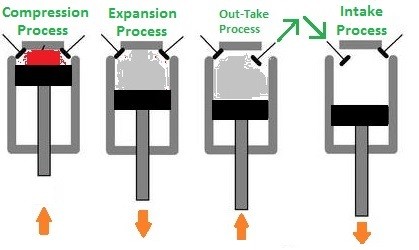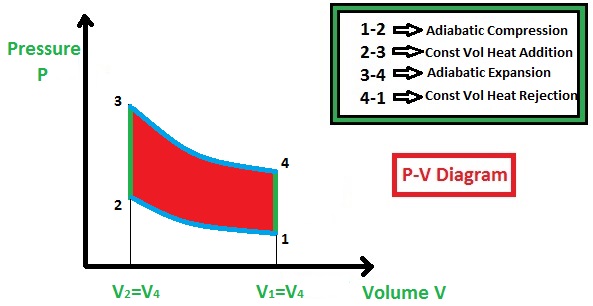What Is Otto Cycle (Internal Combustion Engine)?
Otto Cycle is a type of a Reversible ideal internal combustion engine that uses the petrol or gas as fuel for its working. Otto Cycle can be called Petrol Engine Cycle too. It does consists of four processes and four strokes in its construction. This Cycle observes and rejects the heat for its working so, it is also called as Thermodynamic Cycle. Also Read- What are Thermodynamics and Basic Concepts of Thermodynamics?
- Diesel Cycle – Its Process, Diagram, Limitations, And Efficiency – FAQ’s
Otto Cycle Process:

The Otto Cycle does consist of four strokes and four processes. The four processes of an engine will be responsible for the four strokes and those strokes are responsible for developing the power that results in vehicle movement. Even though it is an ideal internal combustion engine, it plays important role in real life application. The four processes are as follows


Reversible Isentropic Compression Process (1-2):
The process 1-2 is the Reversible Isentropic Compression Process also called Adiabatic Compression Process. In this Otto Cycle Process, the entropy will be constant (which is called as Isentropic Process) and no heat is added or rejected (which is called as Adiabatic Process).
Due to the slight pressure increase, the piston in the cylinder will move from Bottom Dead Centre (BDC) to the Top Dead Centre (TDC). The volume of the internal combustion engine cylinder will be decreased highly due to the piston movement (observe P-V diagram).
This process will be same as Compression Process in the real combustion engines.
Constant Volume Heat Addition Process (2-3):
The process 2-3 is the Constant Volume Heat Addition Process. In this Process, the Heat is added at constant volume so, the entropy and temperature will be increased.
Due to the Constant Volume Heat Addition, the pressure increases highly and the piston in the internal combustion engine cylinder stays at Top Dead Centre (TDC) without any movement.
This process will be same as spark ignition and combustion process in the real combustion engine.
Reversible Isentropic Expansion Process (3-4):
The process 3-4 is the Reversible Isentropic Expansion Process also called Adiabatic Expansion Process. In this Process, the entropy will be constant (which is called as Isentropic Process) and no heat is added or rejected (which is called as Adiabatic Process).
Due to the slight pressure decrease, the piston in the cylinder will move from Top Dead Centre (TDC) to the Bottom Dead Centre (BDC). The volume of the internal combustion engine cylinder will be increased highly due to the piston movement (observe P-V diagram).
This process will be same as Expansion Process process in the real engine.
Constant Volume Heat Rejection Process (4-1):
The process 4-1 is the Constant Volume Heat Rejection Process. In this Process, the Heat is rejected at constant volume so, the entropy and temperature will be decreased.
Due to the Constant Volume Heat Rejection, the pressure decreases highly and the piston in the engine cylinder stays at Bottom Dead Centre (TDC) without any movement.
This process will be same as Out take Process in the real combustion engine.
Also Read:
- What Is Four Stroke Engine, Working Of Four Stroke Engine, Advantages?
- What Is Two Stroke Engine, Working Of Two Stroke Engine – Parts, And Advantages
Efficiency Of Otto Cycle:
As we know that the efficiency is a standard calculating term that states the performance of an internal combustion engine or cycle. If the digit of efficiency is higher, then the performance of cycle is higher.
So, as like Carnot Cycle, the efficiency of the Otto Cycle is defined as the ratio of Work Done to the Heat Absorbed or added. So, the efficiency in mathematical expression will be as follows.

According to the constant volume heat addition process, heat addition and heat rejection can be taken as

Now, substituting the above formula in the equation 1, then

Whereas; according to the isentropic compression and expansion processes, the temperatures will be
 where r is the compression ratio.
where r is the compression ratio.

Therefore the equation 2 becomes

Limitations Of Otto Cycle:
The limitations are
- It is limited to the Petrol and Gas internal combustion engines only and does not work out for diesel engines.
- The efficiency is limited and not able to achieve as much as Carnot Cycle does.
Conclusion:
The air cycles are ideal cycles for every type of combustion engines. As the Cycle is an ideal cycle for petrol and gas engine similarly, there will be another ideal cycle for the diesel engines too. Even though Otto cycle is ideal, it cannot achieve the maximum efficiency. But we can improve and increase the efficiency of the cycle with few methods (will be discuss in the upcoming articles).
Frequently Asked Questions:
1. What Is Meant By Otto Cycle?
Ans: Otto is an ideal internal combustion engine that works with petrol and gas fuels.
2. What Are The Four Strokes Of The Otto Cycle?
The four strokes of Otto Cycle are
- Compression Stroke
- Expansion Stroke
- Suction Stroke
- Exhaust Stroke
3. How Does The Otto Cycle Work?
- According to the working fuel, it works with the petrol and gas.
- According to the processes, the Cycle works with isentropic compression, constant volume heat addition, isentropic expansion, and constant volume heat rejection processes.
- According to the strokes, it does consists of Suction, Compression, Expansion, and Exhaust Strokes.